Yesterday, we published an analysis on the rotations and movements of Leeds United under Marcelo Bielsa in the 2019/20 campaign. To further investigate their performances, we are explaining the pressing and defensive tactics of the team.
The offensive ability of Leeds was highly appreciated by fans this season. Moreover, they were also doing quite well defensively. They had outstanding figures in terms of the defence: 0.75 conceded goals per game, fewest in the league; 29.21 xGA, also the lowest in the league; and 63.4% of defensive duels success rate, ranked second.
In this tactical analysis, we explain the pressing scheme deployed by Bielsa at Leeds this season.
Overview
Compared to the other leagues Bielsa that has coached in, pressing in the EFL Championship might not be the most difficult task. The well-known English style of play was deeply rooted, we hardly could find another team like Leeds that emphasises on offensive positional plays. In Bielsa’s philosophy, his team should not spend much time to defend as they are capable of winning the ball back early.
The team was always trying to win the ball back. They had the best PPDA (6.31, the league average was 9.94) and challenge intensity (9.1, the league average is 6.7) according to Wyscout. In the Leeds squad, their first choice centre-backs Ben White and Liam Cooper stood out with outstanding performance this season. Cooper had a 77.03% success rate in defensive duels, ranked 4th of the league, but credit should be given to the press too.
Pressing scheme
To briefly summarise, the press was designed to force a long pass and win the ball back as soon as possible. There were similarities between their pressing and counter-pressing, which both included high intensity and partial man-marking. Their defence was the collective actions of the players, starting from the striker, and everyone should be involved.
First, man-marking at the midfield was important. The centre was the most important area on the pitch as this was always the closest route to attack the goal. Also, the offensive team could potentially escape by the flanks when being pressed at the centre. Since Bielsa did not want to spend too much effort at the centre, the opposition midfield three were always marked by the Leeds midfielder tightly. This denied the chances for the receiver to operate at the centre, or even eliminated the central options at first.
At a flank, the marking should also be tight too, as both Jack Harrison and Hélder Costa were committed to their defensive duties. This including enforcing instant pressure when the pass was made, maintaining reasonable distance to access multiple options on the pitch. There were variations when either Costa or Harrison formed the first line of the press with Patrick Bamford, and then the corresponding full-back should be covering the off-position winger.
Every return pass was the trigger of the press, the nature of this type of pass was always inviting pressure. This was because the marker could jump to the receiver while shutting his initial target’s passing lane, controlling two players by only one.
The below image included all elements of the Leeds’ press. There were man-markings at the midfield, early engagement from the winger (Harrison) to the right-back. The return pass also triggered Bamford’s press.
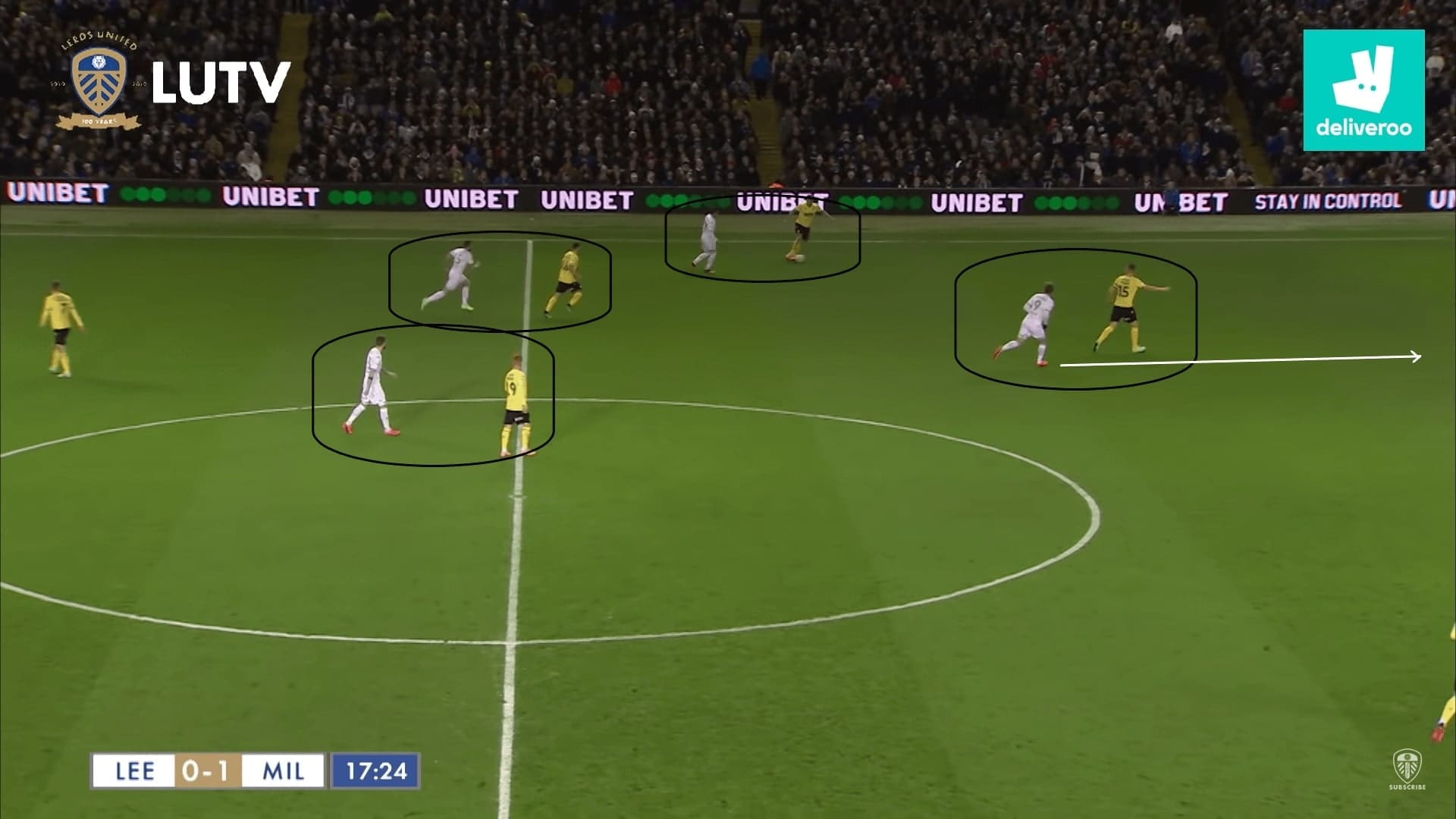
Intriguingly, their press was well-trained with objectives. In the hopes of maximising the effects of man-marking and shutting the escape routes, the pressing player(s) was always approaching the target(s) diagonally or laterally. The responsibility to signal and lead the press fell to Bamford, who was an extremely hardworking player. We will later highlight his significance with a separate section.
The man-marking at the midfield was not dogma as there were also occasions that the midfielder should leave his target. This often happened when Bamford initiated the press and the follow-up was needed. When the winger was staying wide, the job of the second wave of press fell to the midfielder.
This was the situation in this image, as Bamford pressed on the right and Harrison was far away from the receiver, so Pablo Hernández jumped out to press the receiver. On most occasions, when the attacking team faced pressure liked this, they played long to escape the press.
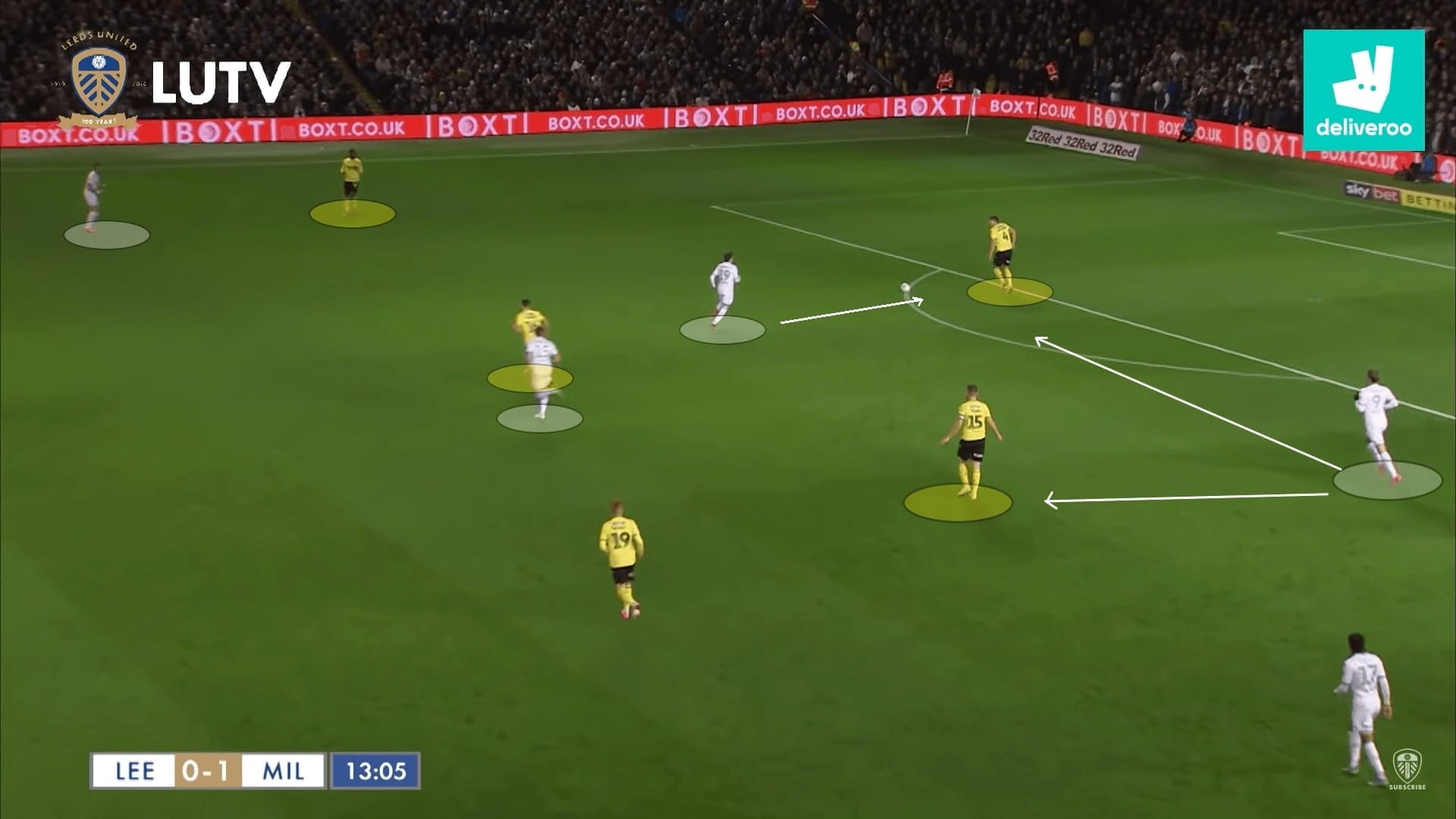
The Leeds players possessed good accessibility during the press. This allowed the player to cover multiple targets when defending and increased the variations of pressing traps. We will explain the pressing traps in the coming section.
The players of Leeds are also equipped with good pressing knowledge and skills – curved-runs were commonly seen and this created multiple benefits. Apart from shutting the passing lanes, the curved-runs also helped Leeds to press in different angles (especially different heights). This increased the difficulties of the attacking players as they had to completely check their surroundings. In the meantime, the intensity and sprints of the press forced the attacking players to decide quicker, and it was almost impossible to perceive information from 360°.
In this image, we could see the pressure towards the ball was coming from two angles. The players were approaching the ball diagonally and laterally. This only gave one option to the receiver as the passing angles were limited. Roughly speaking, the receiver could only pass to the forward option (going backwards was not an option!).
However, this was a pressing trap. As mentioned, even though the distance was large, the Leeds players could still access their targets with their sprints. In this case, Krystian Bielik (Derby No.5) received the pass, and he panics as soon as the remaining two Leeds players were around.
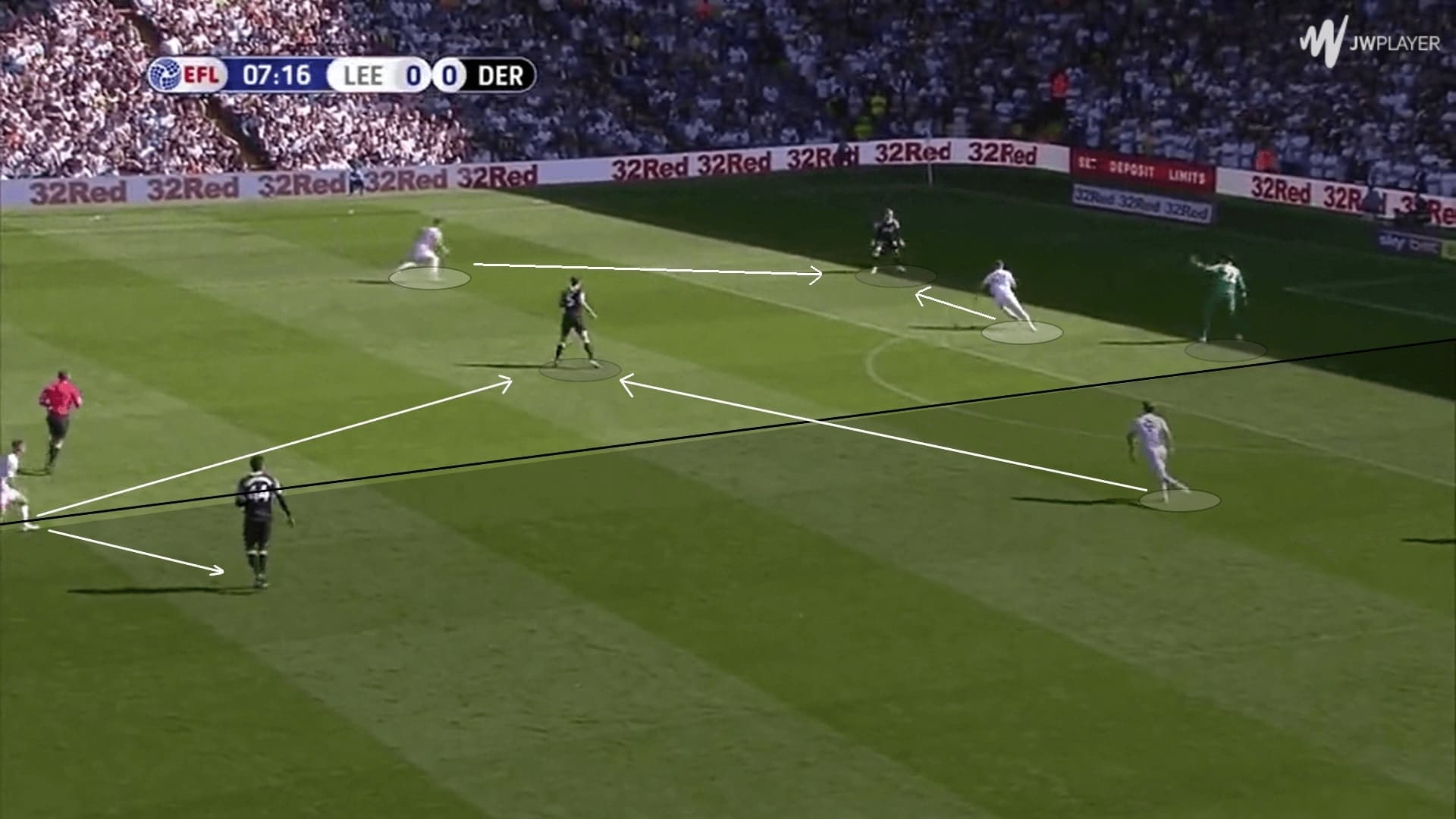
Pressing a back three was similar to pressing a back four, as it was very easy to trigger the long balls. When dealing with the wide centre-backs against a back four, a player would join Bamford to form a two-man forward line. Playing against a back three was no exception, but it was the most important way to control three centre-backs by two players.
This was never a tricky problem with Bamford. The former Chelsea striker was clever to always approach the ball with an optimal angle and body orientation. Taking the below image as an example, Middlesbrough played in a 5-3-2, and Hernández formed the first line with Bamford. The way of Bamford to approach the keeper was clever – as he jumped from the middle centre-back, approaching the ball diagonally, he managed to shut the passing lane to the left centre-back while forcing a long ball.
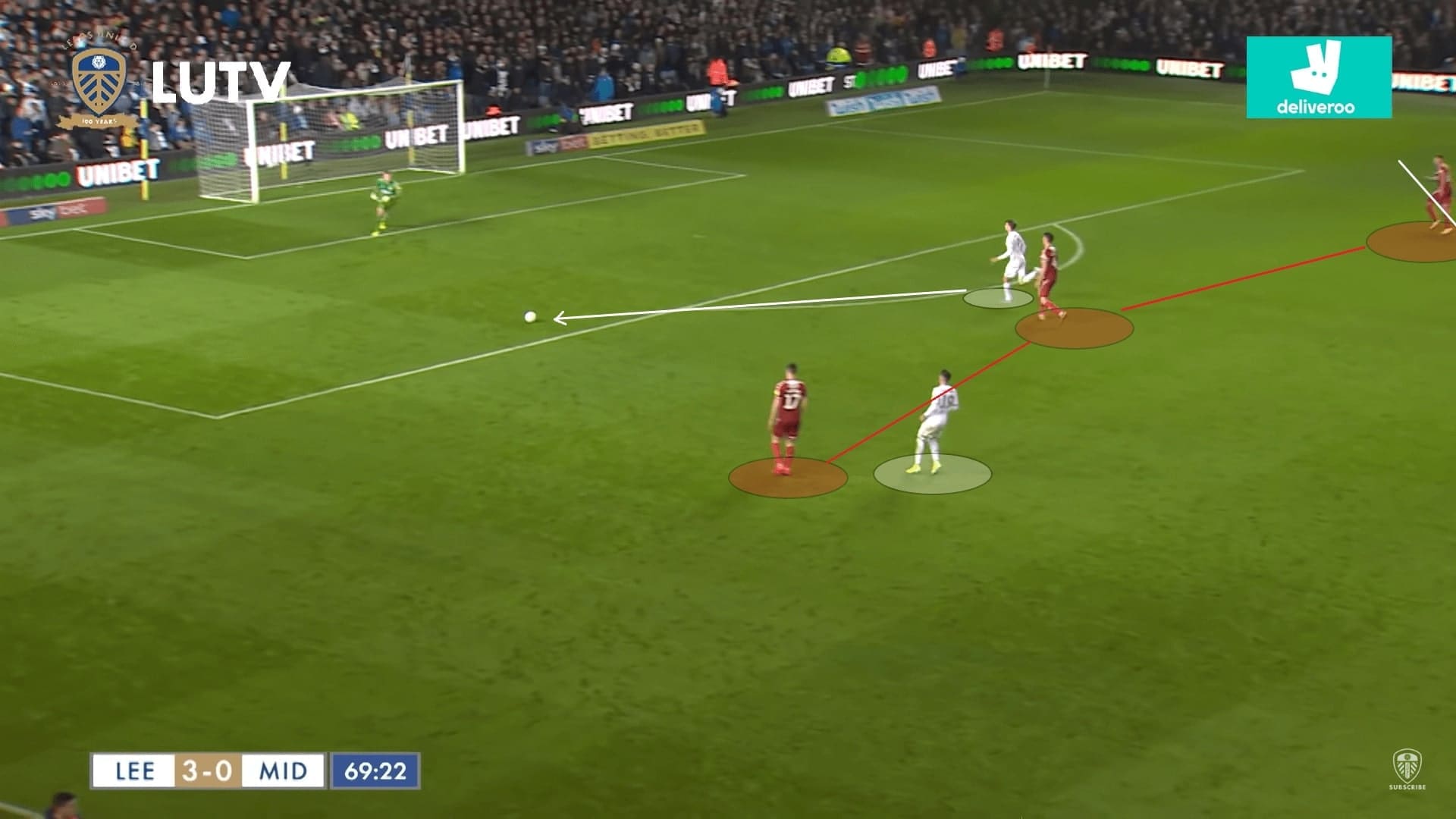
So, why were Leeds forcing the attacking team to play long and how could they dominate it? Firstly, it was because of the numerical advantage generated at the backline. Despite pressing high, the centre-backs seldom left their positions to press, so Bielsa’s team always maintained a 2 v 1 or 3 v 2 (including a full-back against two strikers). This numerical superiority helped them to regain the ball easier. Second, the ability of Cooper in the duels was also an advantage, as explained with stats in the previous section.
Another strategy they used to fight for the second balls was releasing Phillips. As you could see in this image, White jumped out to attempt the aerial duel and Phillips stayed nearby for the second ball. This approach was conducive for their success rate in aerial duels. Since the challenging defender always came from behind, he should perceive more visual information and decide his moment to jump and positioning better.
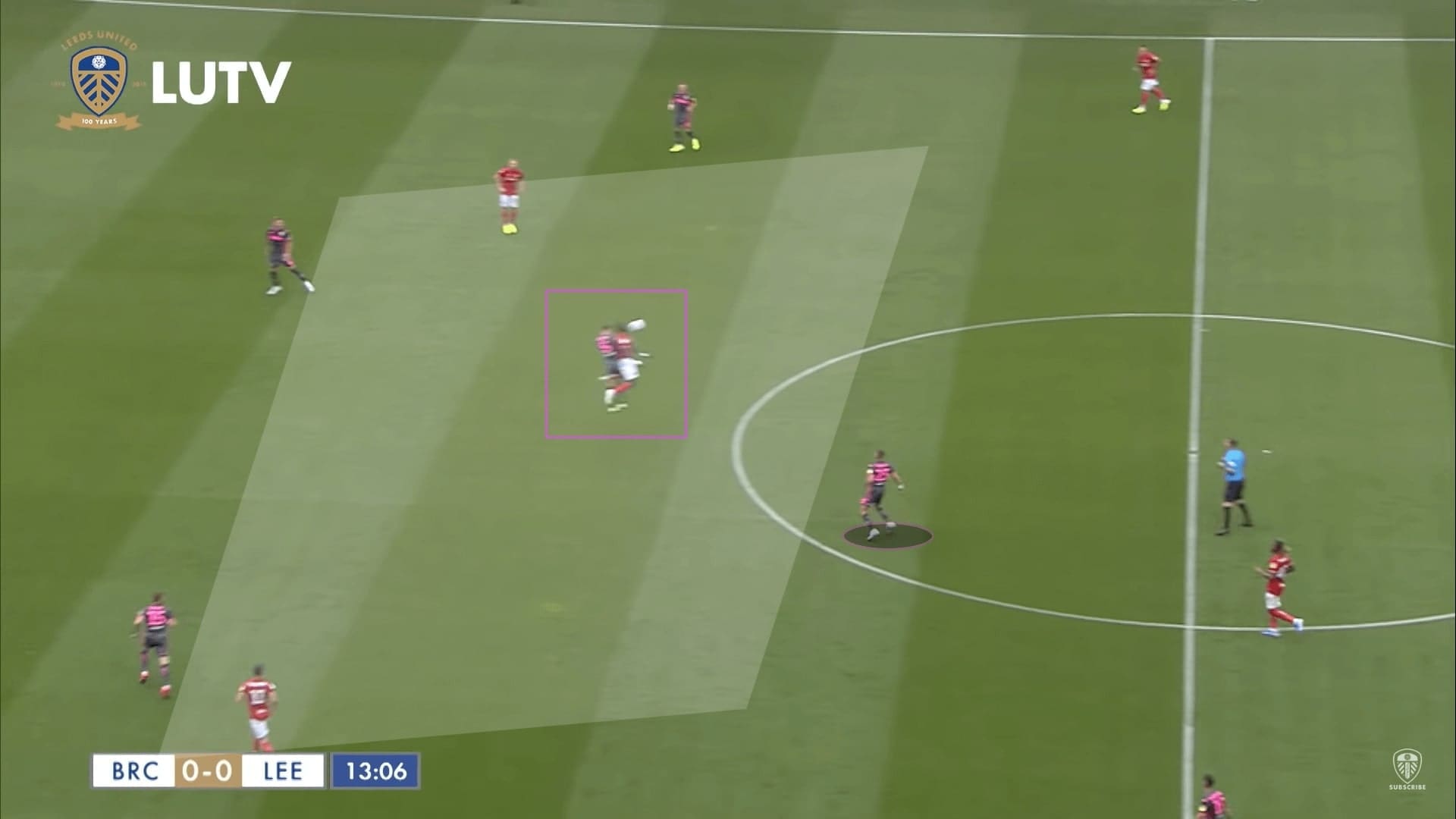
Pressing traps
Just like many other pressing teams, Leeds also set their pressing traps for two aims: forcing a long ball or even recovering the ball high. The core ideas remained the same: man-marking at the midfield, high intensity, and the return pass to trigger the press.
Even when defending the goal kick, Leeds were setting a pressing trap and we used the following image to illustrate this. When the defence pushed high, some direct teams such as Luton Town would play long, and the effects were limited. However, this pressing trap was useful when playing against teams that tried to build up like West Bromwich Albion.
In general, Harrison pushed to form the first line with Bamford, marking both centre-backs. So this was a trap as Harrison (LW) should mark the right-back by position, but now it seemed there was a passing option on the right. Usually, the ball-playing keeper lofted the ball to find the right-back. The left-back (Nathan Ferguson) was neglected as Costa was close to him. When the pass was made, the Leeds left-back (Ezgjan Alioski) would jump to attempt the aerial duel in full sprint. This increased his challenge intensity as he generated more power in the duel, potentially recovering the ball high.
Meanwhile, the rest of the defence shifted and played as a back three, with Phillips and Jamie Shackleton marking their corresponding targets tightly. This was a pretty large scale mix of partial man-marking when possessing numerical superiority.
This might not be a perfect trap as the physical quality of Alioski was questionable, the North Macedonian was 1.71m only according to the Transfermarkt. As supported by the statistics, Alioski was below average in terms of both aerial duels (41.12% success rate, league average: 48%) and defensive duels (57.75%, league average: 60.98%) when comparing the full-backs in the EFL Championship.
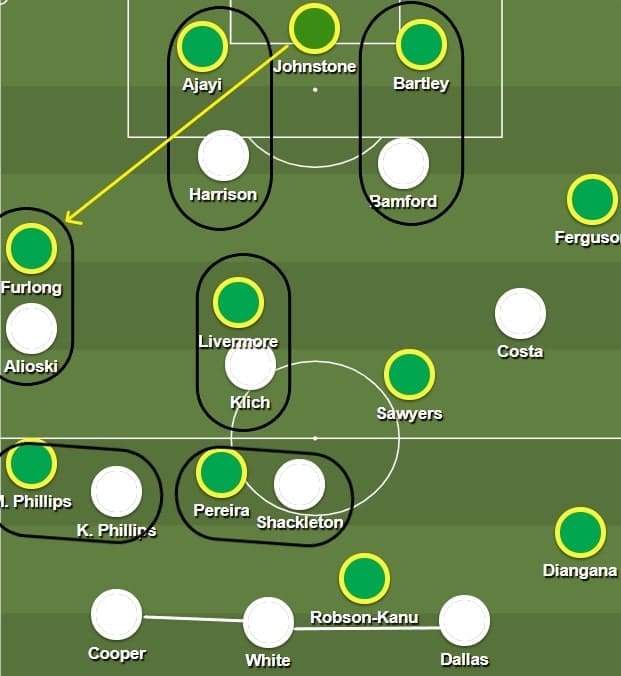
When Leeds were defending the build-up, they set the pressing traps with guiding the ball to the trap (a bait passing lane). The tight man-marking at the midfield was as usual (or, if any midfielder formed the first line with Bamford, Harrison would cover their position). In this case, it was Harrison to form the first line of the press with Bamford. The striker stayed wide to prepare for the lateral or diagonal press, controlling the ball at the half of the pitch.
When Harrison and Bamford split, they opened the central passing lane for the centre-back to the midfielder. However, the receiver should never have the chance to turn or pass as he should be tightly forced with his back to goal. It was Hernández’s duty to pressure Jordan Cousins. Of course, in some better cases, they could even recover the ball when the opponents fell into the first trap, but let us consider the alternative: Cousins could not progress, but he still managed to pass.
Since Harrison was close to access the passer (Cameron Carter-Vickers), the passing lane towards the flank was opened.
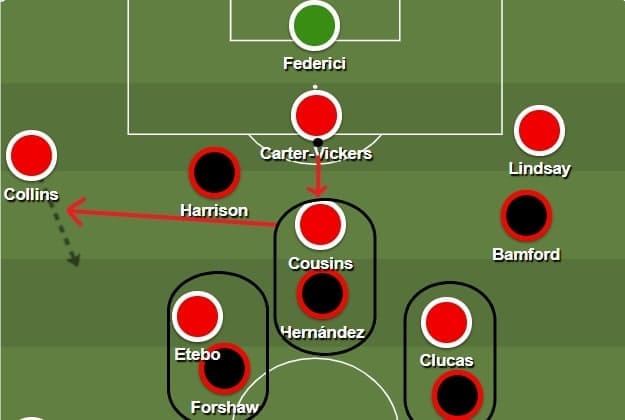
In fact, Leeds had set up a double pressing trap! The first attempt did not win the ball, but they managed to force the ball to the flank, limiting the options of the receiver. When the ball was transferred wide, the first line of Leeds also quickly adjusted their positions.
We will continue with this example. Now Harrison moved wide and he shut the passing lane to the progressive option: Peter Etebo; Hernández shut the return passing lane to Cousins; and Bamford’s action was also vital – as he moved laterally, he shut half of the pitch and the control made the keeper as the only option.
Therefore, the attacking team could not play out from the back, they were forced long and Leeds just won the aerial duels with the method explained in the above section.
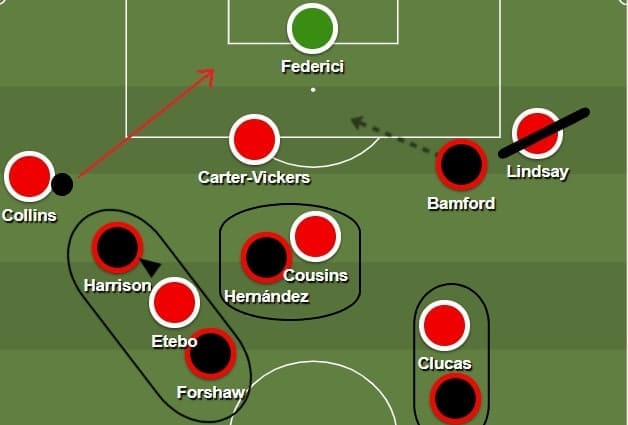
With the intensive press, Leeds could even control the rhythm and urged the opponents to make quicker decisions. Some other important elements of passing lane-orientated pressing such as curved run and shifting were included as well. Also, pressing players like Bamford or Harrison were clever enough to engage in the optimal body shape. As a result, they could even guide the direction and destination of the long passes, which allowed the defence to read the situation early, increasing the chance of success.
The below image can be used as an example. This was a pressing trap as the initial passing lane to the central midfielder was opened, though we understood that the receiver could never turn or progress.
Again, a return pass of Birmingham triggered the press from Harrison. The Manchester City loanee cleverly used a curved run to shut the return passing lane and jumped in front of the receiver. This limited the angle of the long pass and the pass was almost impossible to complete to the right-half of the field. This allowed White to read the pass easier and win the duel.
The Birmingham player was forced to pass instead of timing his pass according to his own will – this was the impact of the pressing trap.
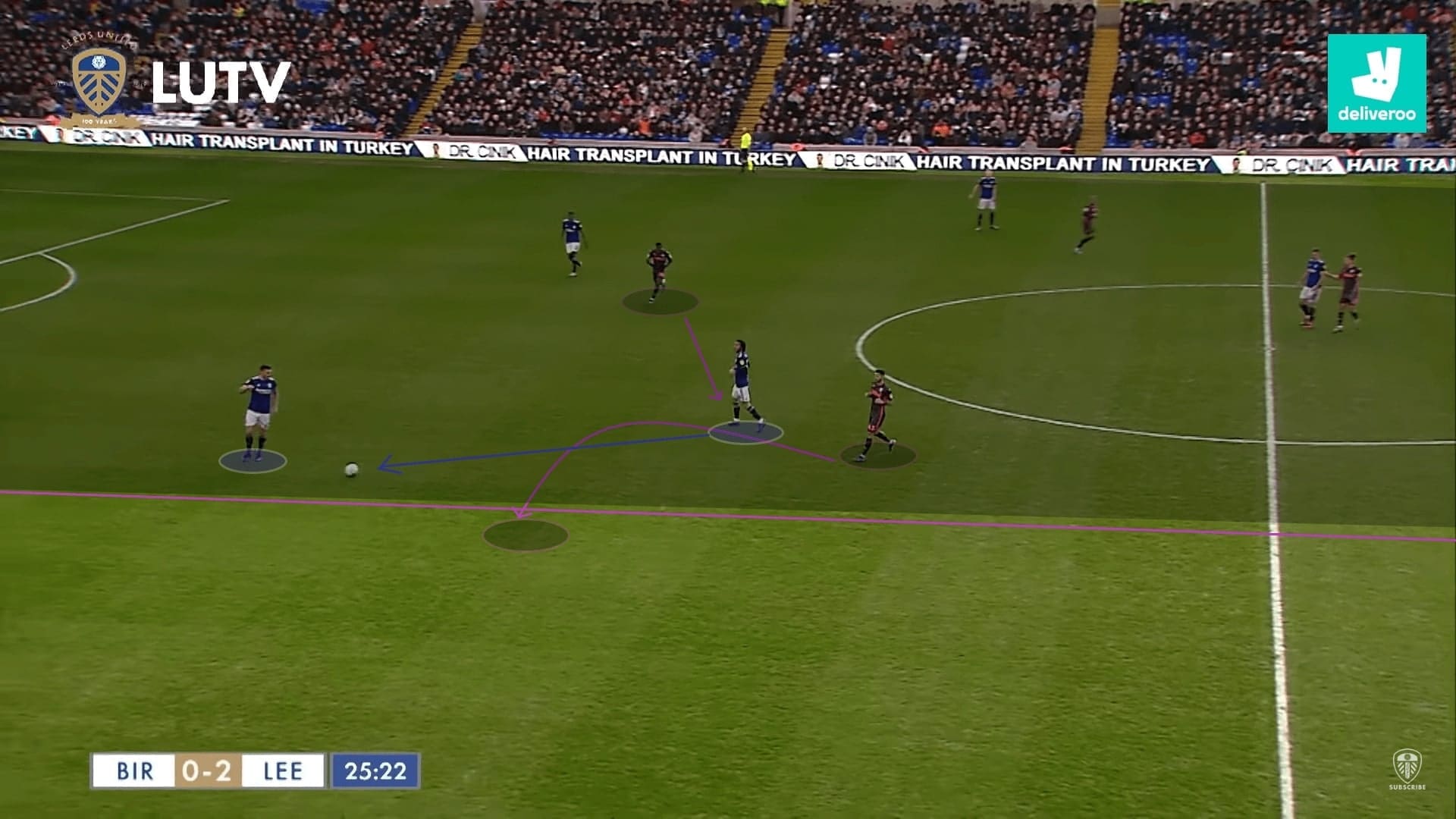
Importance of Bamford
So, how vital was Bamford in the press? The answer is almost irreplaceable. Despite underperforming in front of the goal (he only scored 13 from 21.57 xG), his defensive efforts helped him to become the first-choice striker of Bielsa. With Bamford, the press of Leeds was more complete, the pressing intensity was higher, and the angles of the press were larger.
Bamford has been a very good pressing player. The decision for how he timed his run, how he chose his run, and his commitment were incredible. The biggest impact in a macro aspect was his lateral or diagonal defensive actions. Bamford always pressed the keeper, so his initial position was high when the ball was moved inside Leeds’ block. Then, he spared no pain to come back and compress spaces inside the block, both horizontally and vertically.
Let’s take this scenario as an example. You could see Leeds’ man-marking at the midfield and Harrison’s high positioning. Bamford was approaching the ball diagonally. This run was clever as he shut the right-half of the pitch and where the ball was impossible to play into. Meanwhile, since his accessibility to a target was strong, Semi Ajayi was forced to pass and the destination was guided to the strong side of Leeds, thanks to Bamford’s approaching body angle.
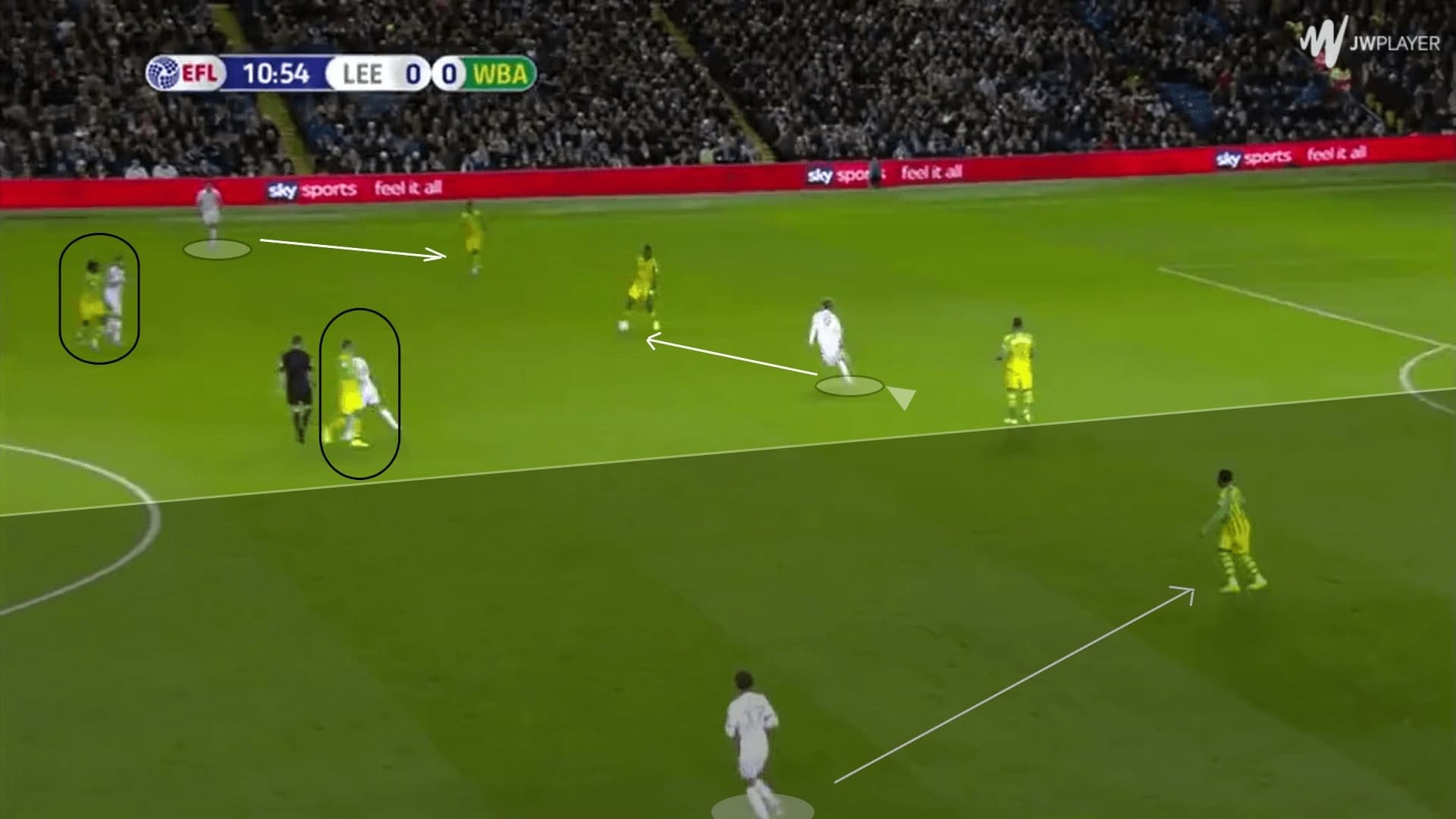
By contrast, both Tyler Roberts and Eddie Nketiah were unable to replicate the energetic displays of Bamford. For example, Leeds conceded four goals at the St. Andrews, and part of the result was because of the unconvincing defensive performances of Nketiah. No matter the stamina, sprints, approaching angle, intensity, and the ability to control the direction of the ball, Nketiah was not on Bamford’s level.
Taking the below image as an example, the keeper could easily roll the ball to a defender according to his own will. This was a very rare situation if Bamford was playing, as he would be staying in front of the keeper already. However, as you could see, Nketiah was still far from accessing the receiver. This allowed Birmingham to construct the attacks comfortably without pressure, and this kept happening throughout the game.
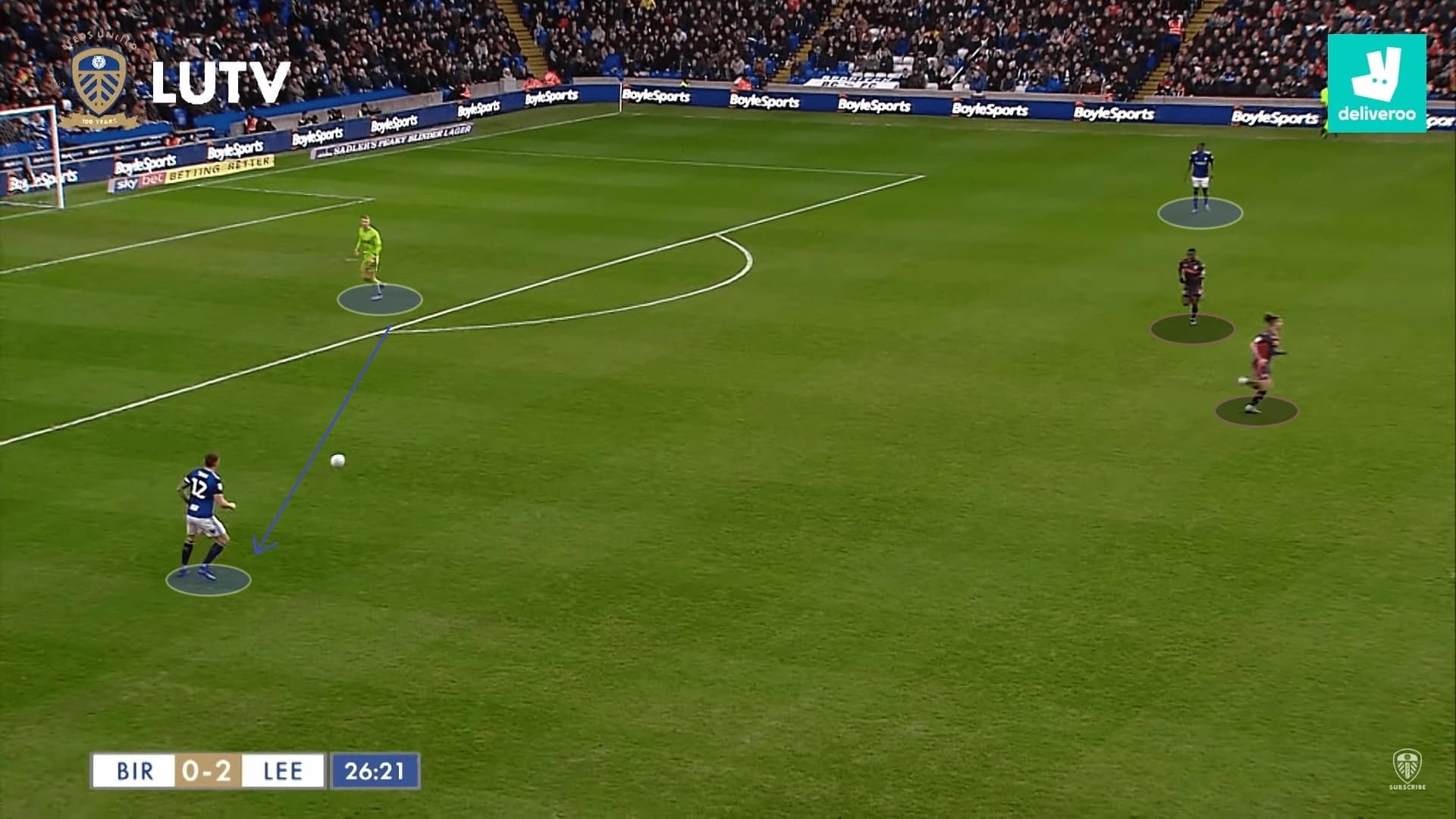
Issues
An imperfect part of Leeds’ press was attributed to their man-marking scheme. This system deployed the midfielders to deal with a corresponding target, in other words, two or three separated 1 v 1 situations. However, the opponents could exploit the system by either manipulating the positionings of markers or even beating them in that 1 v 1. At times the defence might lose compactness in the centre as the defensive positioning of Leeds midfielders were dependant on the targets.
We used the following image as an example. This showed two issues of the man-marking scheme. First, a player was dribbled past and the carrier entered the midfield. There was no cover in the centre as both Phillips and Klich were dragged away by their targets. The triangle indicated the distances between the midfield trio, and how the carrier was able to carry the ball forward.
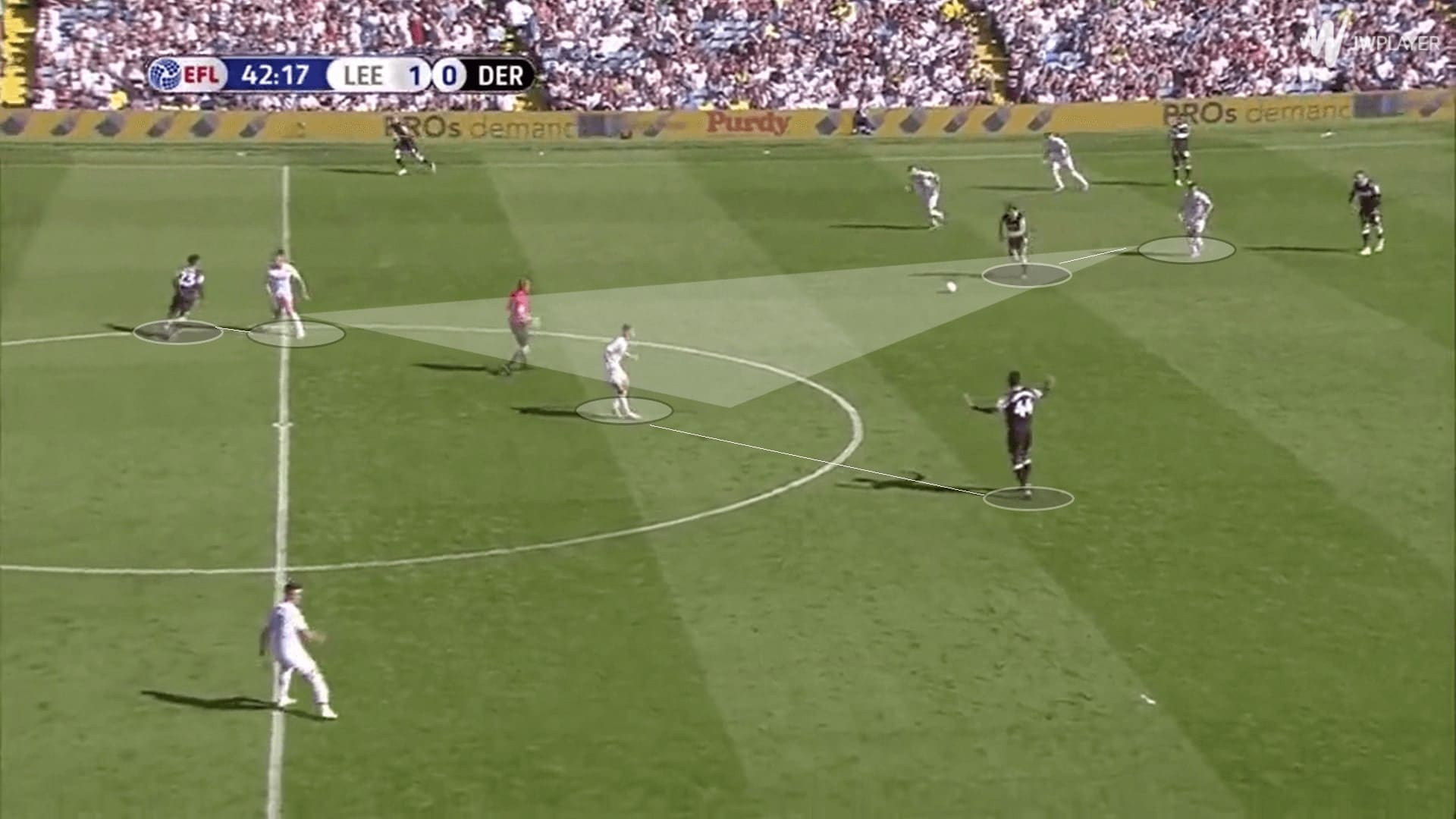
To further elaborate on the defensive positionings, we used the example to show the weakness of this approach. Because of the man-marking, sometimes the Leeds midfielders were obsessed with following the targets instead of protecting the areas. So to bypass the pressure at the centre, the attacking team could just easily progress away from the Leeds midfielders by manipulating their positions. This potentially opened the central passing lanes.
Another issue was that they were fragile when dealing with a ball-playing centre-back. On paper, Bamford was isolated against the centre-backs, he could not always depend on Harrison as the winger had his defensive duties at the flanks too. When the centre-back carried the ball forward after bypassing Bamford, he was not under pressure as the Leeds midfield trio were taken away.
This was the case for Ajayi in this situation. The West Brom centre-back could drift forward over the halfway line. The midfield of Leeds was gone because of the man-marking scheme. Ajayi had many progressive choices and they could easily access Leeds’ offensive third.
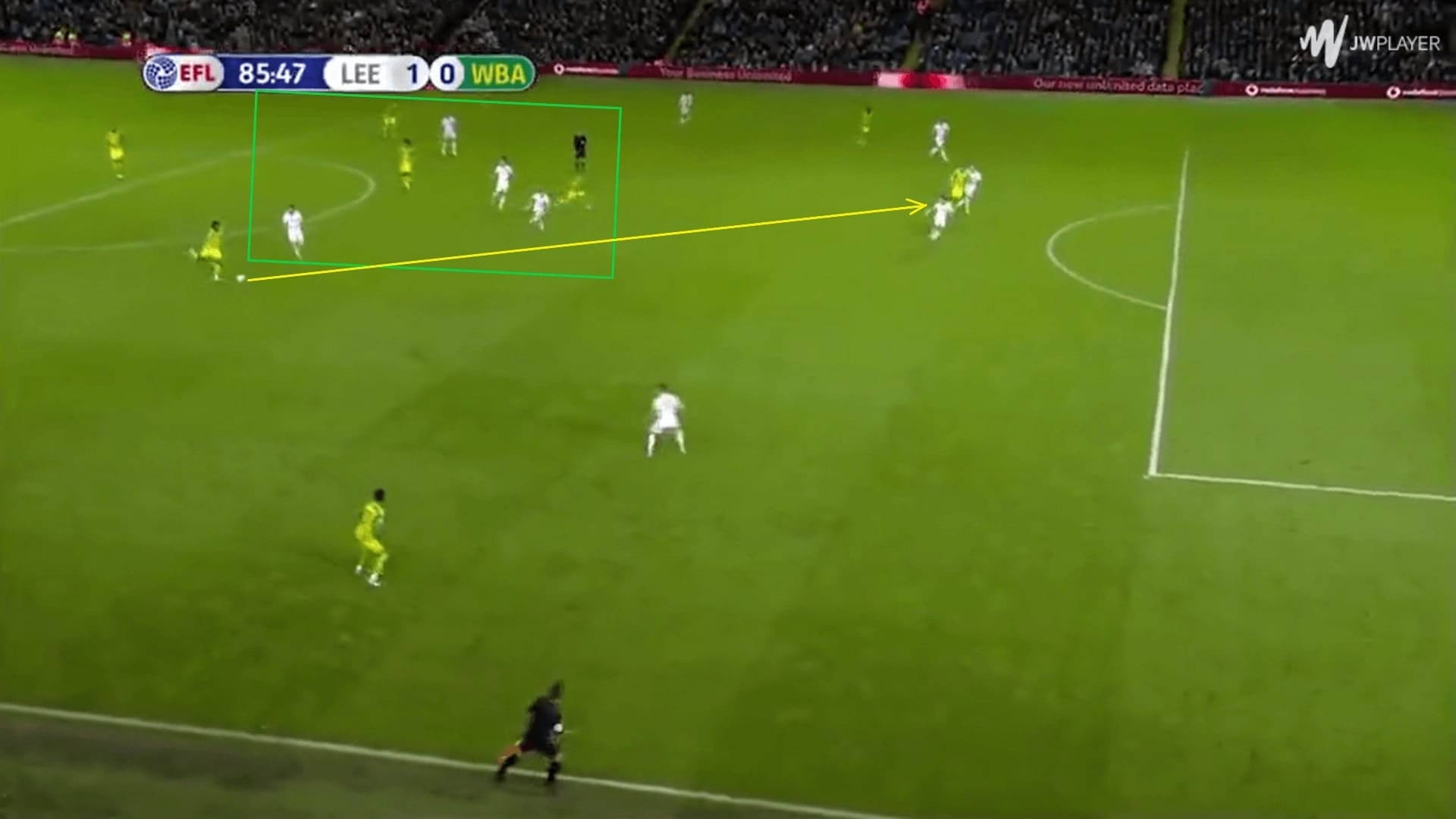
Room for improvements
In the last section of the analysis, we would like to suggest how could Leeds further polish their press. It is related to the individual decisions when initiating the press. The pressing players of Leeds are young: Harrison at 23 years old and Bamford at 24 years old. As mentioned, their accessibilities of targets were strong, and they could cover large areas with relentless runs. However, this also led to reckless decisions at times, such as initiating the press even though the distance was large.
For example, there was a return pass to Ajayi in this image. This triggered the press from Harrison who jumped away from his initial target. In fact, the winger was too far away from accessing the centre-back. As a result, not only did he miss the challenge, his initial target became the receiver and West Brom progressed the attack.
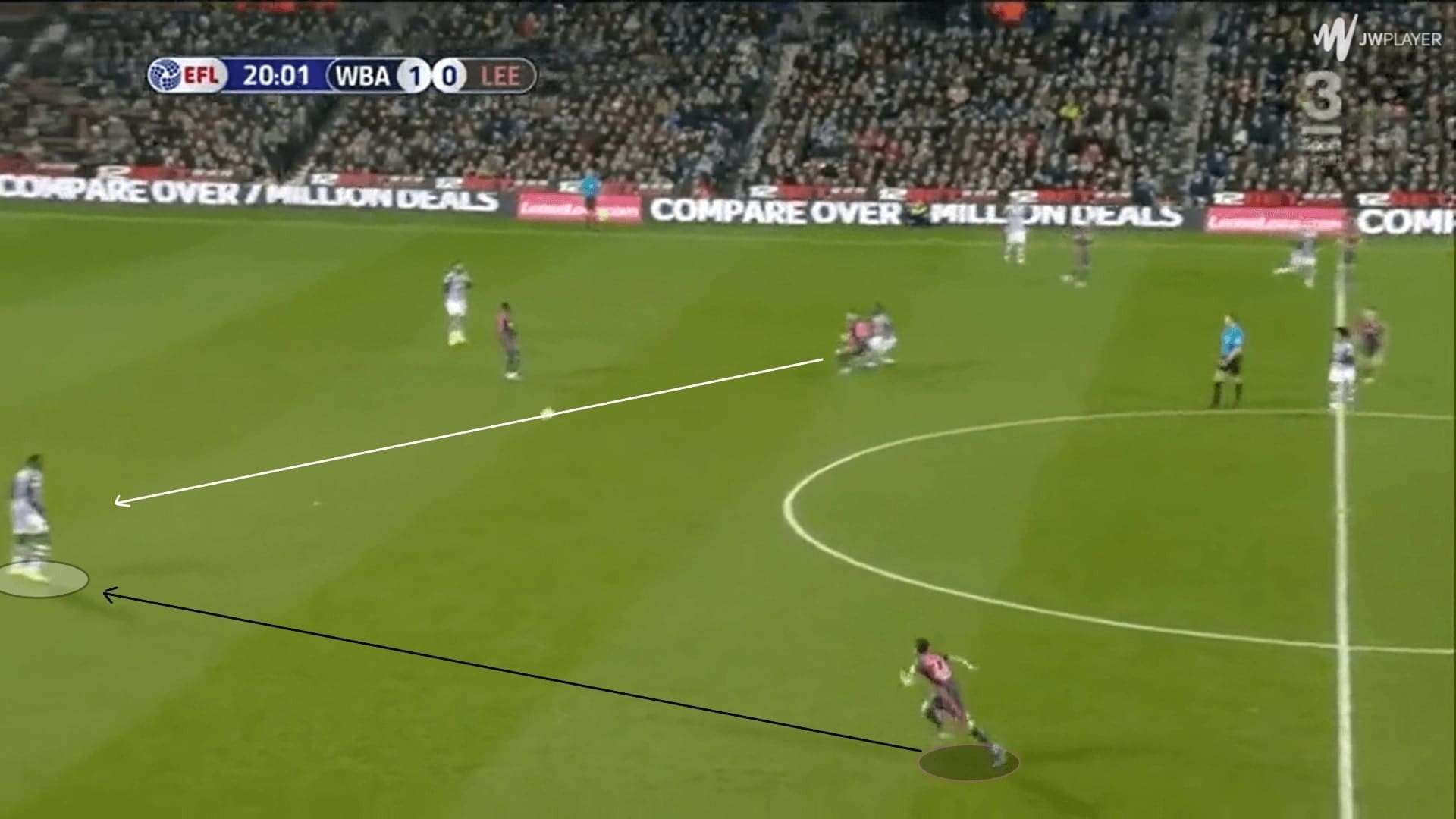
A similar issue was shown below though it was more related to compactness. As mentioned, pressing should be a collective execution of ideas. In hopes of defending efficiently and effectively, they must strike a balance between following the dogmas and judging according to the game situations. On occasion, the player pressed too early while the rest of the team might not be ready for it.
The below image from the Swansea loss was an example. The closest Leeds player to the ball was approaching laterally, but the team was yet to regroup and the markings were was loose. Meanwhile, the Swansea left-back did a great job by providing the width. This prevented Hernández from joining the centre early. With a smooth third-man play, Swansea progressed without facing difficulties. The man-mark failed because of the large areas uncovered on the pitch.
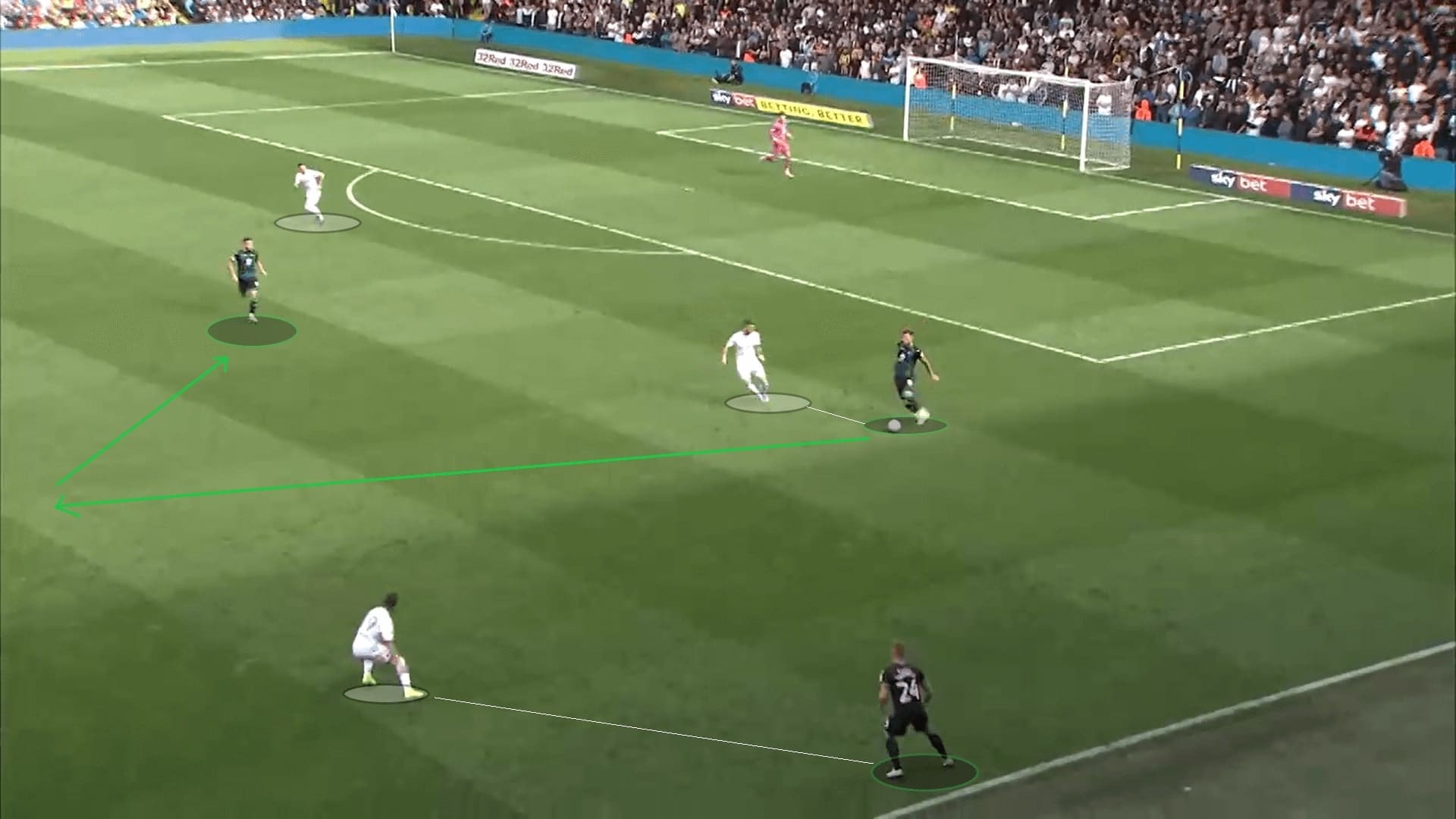
Conclusion
Undoubtedly, Leeds were one of the best pressing team in the league. You would always expect to see intensive pressing from this team, and this was exactly how Leeds did it. In this scout report, we explained that, although there was still room for improvements, the press of Leeds worked in most cases and gave a tough time to their opponents. We will expect to see more from Bielsa’s Leeds in the future.





Comments